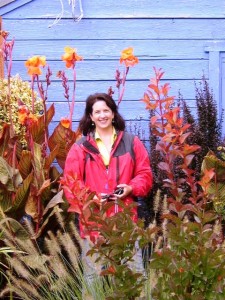Blog Musings: A design writer’s philosophy
[Photo credit: Susan Appleget-Hurst]
I am drawn to the intersection of architecture and horticulture; as an observer and a writer, I watch and interpret how human beings interact with their built environment, and in the larger context, with nature.
My perspective as a writer is shaped by an undergraduate degree in textiles and fashion; graduate-level work in communications; horticultural studies; and more than two decades in newspaper and magazine journalism.
As I observe, consider, inquire, and listen, these senses inform my stories. I write as an independent chronicler, but I seek to be respectful of the subject.
The English title of the French philosopher Gaston Bachelard’s book, The Poetics of Space, sums up the theme of my work.
Bachelard writes about memories of home as a powerful source for poetry and literature:
“. . . all really inhabited space bears the essence of the notion of home. . . .the imagination functions in this direction whenever the human being has found the slightest shelter. . . . if I were asked to name the chief benefit of the house, I should say: the house shelters daydreaming, the house protects the dreamer, the house allows one to dream in peace.”
Every story I report, develop, and write opens a window into the notion of inhabited space as a metaphor for the spirit and character of one’s life. When interviewing an architect, landscape architect, interior designer, artist, or homeowner, I am curious to discover far more than the fundamentals.
Reporting on blueprint and building blocks can accurately communicate practices, techniques, materials, and solutions a design professional may employ. Yet to me, the narrative is incomplete unless I give voice to the human experience within that environment. How is life nurtured and sustained by the designed space? This, to me, is the most important question.
As a journalist, my role is to tell stories to reveal universal themes of shelter, habitat, and environment. Approaching this through a conventional design article may not be within the usual and expected outline of a feature story on these subjects. But I have experienced otherwise in my work.
Humans have an emotional connection with their surroundings; they possess and are possessed by the homes, the rooms, the furnishings, the artwork, and the plant-filled landscapes they create for themselves. Thought-provoking design writing relies on – and honors – this dynamic narrative.
I am very much aware of perceptions that writing about homes and gardens is at best, a predictable genre, or at worst, a cliché. However, I wish to break new ground in this field by writing character-driven narratives deeply rooted in place and setting.
I want to discover and engage in the broader design community, meet and learn from experts in architectural and design fields, and express my personal interests in landscape architecture and garden design. These latter two disciplines are frequently approached after the fact, as a consequence to, rather than an integrated element of, the design of a building. In my work, I seek to change that equation and examine the residence’s entire form, including its “place” in the geography, how the environment informs and determines the design of an emerging structure, and how its occupants interact with the setting.
I seek a balance between interior architecture and exterior (landscape) architecture and horticulture. I see my role as a design journalist to hone in on this confluence of circumstances. It is a holistic approach that I feel I am uniquely equipped to take.
Designing for the built and planted environments is a thread running through my books, ongoing magazine and newspaper articles, and in www.shedstyle.com, my design blog.









